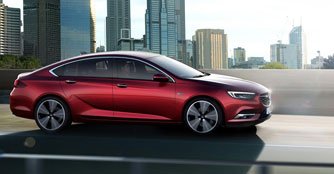All new Opel Insignia gets all-wheel drive with torque vectoring
15 Jan 2017|2,642 views
The mid-size market segment is not usually the place to look for advanced chassis technology but this is set to change when the new Insignia Grand Sport hits the market in early 2017. The Grand Sport, with the all new eight-speed automatic transmission, is available with a state-of-the-art torque vectoring all-wheel drive system that aims to deliver exceptional levels of grip and handling.

As a result, the new Insignia uses an all-wheel drive system with a rear-drive module that employs a twin-clutch system without a differential. The Insignia's all-wheel drive system can apply torque to one or both of the rear wheels independently, enabling torque vectoring capability across the car's full performance range.
When cornering, higher torque is sent to the outside rear wheel, inducing rotation around the vertical axis - the Insignia turns in with more precision, responding spontaneously to inputs from the driver.
Torque vectoring also makes the car safer by controlling the distribution of torque according to changes in throttle position, steering angle and road surface, thus reducing the amount of yaw. This intelligent use of torque distribution, also known as 'yaw damping', results in neutral vehicle behaviour, making the car more stable and steerable for the driver.
The mid-size market segment is not usually the place to look for advanced chassis technology but this is set to change when the new Insignia Grand Sport hits the market in early 2017. The Grand Sport, with the all new eight-speed automatic transmission, is available with a state-of-the-art torque vectoring all-wheel drive system that aims to deliver exceptional levels of grip and handling.
All-wheel drive and torque vectoring is the best way to put high power onto the road, be it wet, dry, icy or covered in snow. But, the additional weight and complexity of conventional torque vectoring systems prevent them from meeting Opel's high standards for performance and efficiency.
As a result, the new Insignia uses an all-wheel drive system with a rear-drive module that employs a twin-clutch system without a differential. The Insignia's all-wheel drive system can apply torque to one or both of the rear wheels independently, enabling torque vectoring capability across the car's full performance range.
When cornering, higher torque is sent to the outside rear wheel, inducing rotation around the vertical axis - the Insignia turns in with more precision, responding spontaneously to inputs from the driver.
Torque vectoring also makes the car safer by controlling the distribution of torque according to changes in throttle position, steering angle and road surface, thus reducing the amount of yaw. This intelligent use of torque distribution, also known as 'yaw damping', results in neutral vehicle behaviour, making the car more stable and steerable for the driver.
Latest COE Prices
May 2025 | 1st BIDDING
NEXT TENDER: 21 May 2025
CAT A$103,009
CAT B$119,890
CAT C$62,590
CAT E$118,889
View Full Results Thank You For Your Subscription.




















